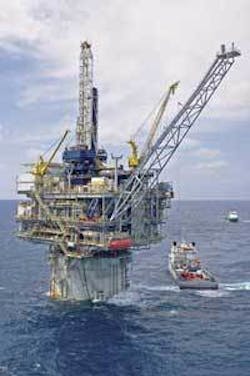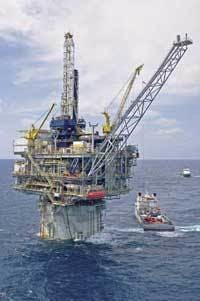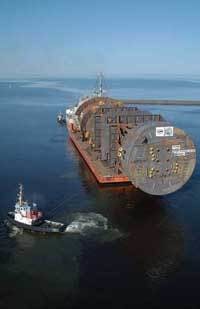GULF OF MEXICO
David Paganie • Houston
null
Constitution onstream
Kerr-McGee achieved first production from one of six dry-tree wells planned on its $600-million Constitution field, located in Green Canyon blocks 679 and 680.
All wells will be processed through 12-in. production risers connected to theConstitution truss spar, designed to handle 70,000 b/d and 200 MMcf/d. The floating production unit is installed on GC 680 in 5,000 ft of water.
The company expects to reach peak production volumes of approximately 40,000 b/d and 75 MMcf/d from the six dry-tree wells by the end of this year. The Constitution field has estimated reserves of approximately 110 MMboe.
Two subsea wells from the nearby Ticonderoga field, located in Green Canyon block 764, began flowing through the spar in February. The wells are currently producing at a peak rate of about 22,000 b/d and 19 MMcf/d.
Processed oil fromConstitution flows to Platform B in Ship Shoal block 332 for export, via 67 mi of 16-in. rigid pipeline, and produced gas flows through 30 mi of 16-in. pipe to a subsea PLET in Green Canyon block 241 for export.
Kerr-McGee first drilled on Constitution with discovery well No. 1 in 2002, and later confirmed the field’s commercial potential with 11 penetrations into oil-bearing sands in seven reservoirs. The initial development plan was sanctioned in January 2004. The plan was then modified to accommodate production from the discovery of Ticonderoga in April 2004.
Kerr-McGee is 100% owner and operator of Constitution. Ticonderoga is operated by Kerr-McGee with a 50% working interest, and Noble Energy holds the remaining 50%
Knotty Heads-up
Nexen is a step closer in drafting a viable field development plan for its Knotty Head discovery, with the conclusion of drilling and logging operations on a sidetrack well on Green Canyon block 512. Transocean drilled the well with its drillship,Discoverer Spirit.
The field’s discovery well was drilled in 2005 in 3,500 ft of water, to a total depth of 34,189 ft and encountered approximately 600 ft of net oil pay in multiple zones, according to the operator. The sidetrack well was drilled downdip to a total depth of 32,986 ft, with a bottomhole location approximately 4,500 ft to the south of the original wellbore. The sidetrack encountered all reservoirs seen in the discovery well and approximately 400 ft of net oil pay were logged.
Based on drilling results on the field so far, Nexen estimates the field’s potential reserves at between 200 to 500 MMboe. The company plans to continue appraisal drilling on the field in order to draw a more accurate estimate of the field’s commercial potential and to formulate a feasible development plan. According to the initial exploration plan filed by the operator in November 2004, at least four wells are scheduled to be drilled on GC 512.
Additionally, the company plans to spud a stand-alone appraisal well, likely off to the west of the discovery, later this year to help size-up the field. However, at print, the company indicated that it was still working on securing a rig for the well.
Overall, the operator is confident that it is progressing on-track for a major deepwater project in the near future. “We expect that we will have a significant development to undertake in the GoM at Knotty Head during the 2007/2008 timeframe,” said Marvin Romanow, Nexen EVP and CFO, in a conference call while announcing the company’s 2006 capital budget.
Nexen is the operator of the block with a 25% working interest. Other owners include Anadarko (25%), BHP Billiton (25%), and Chevron (25%).
Pre-insulated pipe favored in deepwater
As operators continue to push the limits of deepwater E&P in the GoM, flow assurance challenges will increase. These operational and technical challenges must be confronted in order to maintain optimal movement of fluid through the production system.
Subsea challenges that come with deepwater environments include high external ambient pressures and cold seawater temperatures. The large external pressures are due to hydrostatic pressures of the water at the seafloor, where subsea production facilities are located. As a result, associated flowlines are prone to paraffin or hydrate buildup, which could slow or block the flow of oil.
One method commonly used to overcome these challenges is to insulate the flowlines. One pipe manufacture that is benefiting from the industry’s increasing use of insulated pipe, or pipe-in-pipe solutions for deepwater developments, is MRFI Inc.
Its subsidiary, Perma-Pipe Inc., recently received almost $22 million in new orders to pre-insulate subsea flowlines from major and independent oil and gas companies for application in the deep waters of the GoM.
Perma will apply its Auto-Therm, automatically applied glass syntactic polyurethane (GSPU) thermal insulation process, to the exterior of the steel pipe incorporated into flowlines and risers that connect subsea wells to host facilities. The company initially began receiving orders for this relatively new product in 3Q 2005.
According to Perma-Pipe, the Auto-Therm is designed to provide reliable insulation properties when subjected to large hydrostatic pressures in deep water over long periods of time. The specially formulated compound can be used for flowlines installed in water depths ranging from 2,000 to 6,500 ft of water.
The products will be manufactured at the company’s facility in New Iberia, Louisiana. All orders are expected to be completed by year-end 2006.
In addition, Perma-Pipe received $3.5 million in new orders for its Xtru-Therm polyurethane foam and PE jacket for pipe-in-pipe and shallow water applications. These orders will be applied in encased pipeline applications in deep water, and for a shallow water project outside the US.
Central GoM Sale 198
The latest Central GoM Lease Sale, 198, attracted $588,309,791 in high bids from 82 companies. The total of all bids was $978,310,887, up 38% from last year’s Central Gulf Sale.
The sale, held in New Orleans, drew a total of 707 bids on 405 tracts; 4,040 blocks were offered comprising approximately 21.3 million acres offshore Alabama, Louisiana, and Mississippi.
“While interest in deepwater production continues, the large number of tracts receiving bids in shallow water is of particular note, indicating industry interest in deep gas in shallow waters,” says the MMS. Central lease sale statistics compiled by the agency over the years indicate that Sale 198 represents the largest sum of deepwater high bids, and overall high bids, since 1998.
According to an equity research analyst, “Lease Sale 198 exemplifies what we believe to be indicative of the industry taking more geological and economic deepwater risk in search of potentially larger oil and gas reserves.”
Amerada Hess Corp. submitted the highest bid on Green Canyon block 287 for $42,789,994, followed by Newfield Exploration Co. and Anadarko Petroleum Corp., who submitted the second highest bid on Green Canyon block 551 for $33,989,760.
According to the MMS, each of the high bids will be evaluated before a lease is awarded.
Meanwhile, the MMS issued a notice proposing to hold Western GoM Lease Sale 200 on August 16, 2006. The proposed sale includes 3,787 unleased blocks covering approximately 20.4 million acres in the western Gulf offshore Texas and Louisiana. The blocks are situated from nine to 210 mi offshore, in up to 3,425 m of water. The MMS says sale results could result in the production of 136 to 262 MMbbl of oil and 0.81 to 1.44 tcf of natural gas.
| Capacity | 70,000 b/d of oil; 200 MMcf/d of gas |
| Spar length | 554 ft (50 ft above water) |
| Spar diameter | 98 ft |
| Hull weight | 14,800 tons |
| Hull design | Technip |
| Hull fabricator | Technip |
| Topsides payload | 10,770 tons |
| Workover deck | 113 x 159 ft |
| Main deck | 127 x 163 ft |
| Cellar deck | 127 x 176 ft |
| Topside design | .Mustang Engineering |
| Topside fabricator | Gulf Island Fabricators |
| Hull & topside installation | Heerema Marine Contractors |
| Mooring | Permanent,taut catenary system; nine-leg (3 x 3 grouping) - each leg consisting of permanent anchor pile, anchor chain, jacketed steel spiral strand wire, platform chain, underwater fairlead and chain jack |
| Subsea design (Ticonderoga) | JP Kenny |
| Export pipelines (owner/operator) | Enterprise Products Partners (Gulfterra) |
| Location | Green Canyon block 680 |
| Water depth | 5,000 ft |
| Dry-tree wells | .6 (12-in. production risers) |
| Subsea tiebacks | 2 wells initially (Ticonderoga) |
| Gas export | Enterprise (Gulfterra) |
| Oil export | Enterprise (Gulfterra) |



